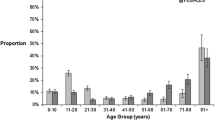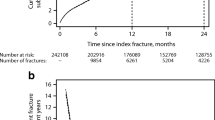Abstract
To reduce the burden of fracture, not only does bone fragility need to be addressed, but also injury prevention. Thus, fracture epidemiology irrespective of degree of trauma is informative. We aimed to determine age-and-sex-specific fracture incidence rates for the Barwon Statistical Division, Australia, 2006–2007. Using radiology reports, incident fractures were identified for 5342 males and 4512 females, with incidence of 210.4 (95 % CI 204.8, 216.2) and 160.0 (155.3, 164.7)/10,000/year, respectively. In females, spine (clinical vertebral), hip (proximal femoral) and distal forearm fractures demonstrated a pattern of stable incidence through early adult life, with an exponential increase beginning in postmenopausal years for fractures of the forearm followed by spine and hip. A similar pattern was observed for the pelvis, humerus, femur and patella. Distal forearm, humerus, other forearm and ankle fractures showed incidence peaks during childhood and adolescence. For males, age-related changes mimicked the female pattern for fractures of the spine, hip, ribs, pelvis and humerus. Incidence at these sites was generally lower for males, particularly among the elderly. A similar childhood-adolescent peak was seen for the distal forearm and humerus. For ankle fractures, there was an increase during childhood and adolescence but this extended into early adult life; in contrast to females, there were no further age-related increases. An adolescent-young adult peak incidence was observed for fractures of the face, clavicle, carpal bones, hand, fingers, foot and toe, without further age-related increases. Examining patterns of fracture provides the evidence base for monitoring temporal changes in fracture burden, and for identifying high-incidence groups to which fracture prevention strategies could be directed.


Similar content being viewed by others
References
Otmar R, Kotowicz MA, Brennan SL, Bucki-Smith G, Korn S, Pasco JA (2013) Personal and psychosocial impacts of clinical fracture in men. J Men’s Health 10:22–27
Pasco JA, Sanders KM, Hoekstra FM, Henry MJ, Nicholson GC, Kotowicz MA (2005) The human cost of fracture. Osteoporos Int 16:2046–2052
Center J, Nguyen T, Schneider D, Sambrook P, Eisman J (1999) Mortality after all major types of osteoporotic fracture in men and women: an observational study. Lancet 353:878–882
Briggs AM, Sun W, Miller LJ, Geelhoed E, Huska A, Inderjeeth CA (2015) Hospitalisations, admission costs and re-fracture risk related to osteoporosis in Western Australia are substantial: a 10-year review. Aust N Z J Public Health. doi:10.1111/1753-6405.12381
Sanders KM, Seeman E, Ugoni AM, Pasco JA, Martin TJ, Skoric B, Nicholson GC, Kotowicz MA (1999) Age- and gender-specific rate of fractures in Australia: a population-based study. Osteoporos Int 10:240–247
Morgan DB, Newton-John HF (1969) Bone loss and senescence. Gerontologia 15:140–154
Kiebzak GM, Smith R, Gundberg CC, Howe JC, Sacktor B (1988) Bone status of senescent male rats: chemical, morphometric, and mechanical analysis. J Bone Miner Res 3:37–45
Bouxsein ML, Melton LJ 3rd, Riggs BL, Muller J, Atkinson EJ, Oberg AL, Robb RA, Camp JJ, Rouleau PA, McCollough CH, Khosla S (2006) Age- and sex-specific differences in the factor of risk for vertebral fracture: a population-based study using QCT. J Bone Miner Res 21:1475–1482
Melton LJ 3rd, Riggs BL, Keaveny TM, Achenbach SJ, Hoffmann PF, Camp JJ, Rouleau PA, Bouxsein ML, Amin S, Atkinson EJ, Robb RA, Khosla S (2007) Structural determinants of vertebral fracture risk. J Bone Miner Res 22:1885–1892
Zebaze RM, Ghasem-Zadeh A, Bohte A, Iuliano-Burns S, Mirams M, Price RI, Mackie EJ, Seeman E (2010) Intracortical remodelling and porosity in the distal radius and post-mortem femurs of women: a cross-sectional study. Lancet 375:1729–1736
Fazzalari NL, Kuliwaba JS, Forwood MR (2002) Cancellous bone microdamage in the proximal femur: influence of age and osteoarthritis on damage morphology and regional distribution. Bone 31:697–702
Sanders KM, Pasco JA, Ugoni AM, Nicholson GC, Seeman E, Martin TJ, Skoric B, Panahi S, Kotowicz MA (1998) The exclusion of high trauma fractures may underestimate the prevalence of bone fragility fractures in the community: the Geelong Osteoporosis Study. J Bone Miner Res 13:1337–1342
Mackey DC, Lui LY, Cawthon PM, Bauer DC, Nevitt MC, Cauley JA, Hillier TA, Lewis CE, Barrett-Connor E, Cummings SR (2007) High-trauma fractures and low bone mineral density in older women and men. JAMA 298:2381–2388
Randell A, Sambrook P, Nguyen T, Lapsley H, Jones G, Kelly P, Eisman J (1995) Direct clinical and welfare costs of osteoporotic fractures in elderly men and women. Osteoporos Int 5:427–432
Pasco JA, Nicholson GC, Kotowicz MA (2012) Cohort profile: Geelong Osteoporosis Study. Int J Epidemiol 41:1565–1575
Henry MJ, Pasco JA, Nicholson GC, Seeman E, Kotowicz MA (2000) Prevalence of osteoporosis in Australian women: Geelong Osteoporosis Study. J Clin Densitom 3:261–268
Pasco JA, Henry MJ, Gaudry TM, Nicholson GC, Kotowicz MA (1999) Identification of incident fractures: the Geelong Osteoporosis Study. Aust N Z J Med 29:203–206
Fay MP, Feuer EJ (1997) Confidence intervals for directly standardized rates: a method based on the gamma distribution. Stat Med 16:791–801
Aragon TJ (2012) Epitools: Epidemiology Tools. R Package version 0.5-7
Jean S, O’Donnell S, Lagace C, Walsh P, Bancej C, Brown JP, Morin S, Papaioannou A, Jaglal SB, Leslie WD (2013) Trends in hip fracture rates in Canada: an age-period-cohort analysis. J Bone Miner Res 28:1283–1289
Rosengren BE, Ahlborg HG, Mellstrom D, Nilsson JA, Bjork J, Karlsson MK (2012) Secular trends in Swedish hip fractures 1987–2002: birth cohort and period effects. Epidemiology 23:623–630
Court-Brown CM, Caesar B (2006) Epidemiology of adult fractures: a review. Injury 37:691–697
Rosengren BE, Karlsson M, Petersson I, Englund M (2015) The 21st-century landscape of adult fractures: cohort study of a complete adult regional population. J Bone Miner Res 30:535–542
Leslie WD, O’Donnell S, Jean S, Lagace C, Walsh P, Bancej C, Morin S, Hanley DA, Papaioannou A (2009) Trends in hip fracture rates in Canada. JAMA 302:883–889
Jaglal SB, Weller I, Mamdani M, Hawker G, Kreder H, Jaakkimainen L, Adachi JD (2005) Population trends in BMD testing, treatment, and hip and wrist fracture rates: are the hip fracture projections wrong? J Bone Miner Res 20:898–905
Kannus P, Niemi S, Parkkari J, Palvanen M, Vuori I, Jarvinen M (2006) Nationwide decline in incidence of hip fracture. J Bone Miner Res 21:1836–1838
Pasco JA, Brennan SL, Henry MJ, Nicholson GC, Sanders KM, Zhang Y, Kotowicz MA (2011) Changes in hip fracture rates in southeastern Australia spanning the period 1994–2007. J Bone Miner Res 26:1648–1654
Fisher AA, O’Brien ED, Davis MW (2009) Trends in hip fracture epidemiology in Australia: possible impact of bisphosphonates and hormone replacement therapy. Bone 45:246–253
Stephens AS, Toson B, Close JC (2014) Current and future burden of incident hip fractures in New South Wales, Australia. Arch Osteoporos 9:200
Donaldson LJ, Cook A, Thomson RG (1990) Incidence of fractures in a geographically defined population. J Epidemiol Commun Health 44:241–245
Rennie L, Court-Brown CM, Mok JY, Beattie TF (2007) The epidemiology of fractures in children. Injury 38:913–922
Singer BR, McLauchlan GJ, Robinson CM, Christie J (1998) Epidemiology of fractures in 15,000 adults: the influence of age and gender. J Bone Joint Surg Br 80:243–248
Shi N, Foley K, Lenhart G, Badamgarav E (2009) Direct healthcare costs of hip, vertebral, and non-hip, non-vertebral fractures. Bone 45:1084–1090
Kanis JA, Johnell O, Oden A, Johansson H, McCloskey E (2008) FRAX and the assessment of fracture probability in men and women from the UK. Osteoporos Int 19:385–397
Cooper C, Atkinson EJ, O’Fallon WM, Melton LJI (1992) Incidence of clinically diagnosed vertebral fractures: a population based study in Rochester, Minnesota. J Bone Miner Res 7:221–227
Kotowicz MA, Melton L Jr, Cooper C, Atkinson EJ, O’Fallon WM, Riggs BL (1994) Risk of hip fracture in women with vertebral fracture. J Bone Miner Res 9:559–605
Holloway KL, Moloney DJ, Brennan-Olsen SL, Kotowicz MA, Bucki-Smith G, Morse AG, Timney EN, Dobbins AG, Hyde NK, Pasco JA (2015) Carpal and scaphoid fracture incidence in south-eastern Australia: an epidemiologic study. Arch Osteoporos 10:215
Holloway KL, Bucki-Smith G, Morse AG, Brennan-Olsen SL, Kotowicz MA, Moloney DM, Sanders KM, Korn S, Timney EN, Dobbins AG, Pasco JA (2015) Humeral fractures in south-eastern Australia: epidemiology and risk factors. Calcif Tissue Int. doi:10.1007/s00223-015-0039-9
Acknowledgments
The study was supported by Australia National Health and Medical Research Council (NHMRC; project 628582), the Geelong Region Medical Research Foundation, the Arthritis Foundation of Australia and Amgen (Europe) GmBH but they played no part in the design or conduct of the study; collection, management, analysis, and interpretation of the data; or in preparation or review of the manuscript. SLB-O was supported by an Alfred Deakin Postdoctoral Fellowship, LJW by a NHMRC Career Development Fellowship (1064272) and NKH by an Australian Postgraduate Award.
Author information
Authors and Affiliations
Corresponding author
Ethics declarations
Conflicts of interest
Julie A. Pasco, Sharon L. Brennan-Olsen, Lana J. Williams and Mark A. Kotowicz have received funding from the NHMRC; Julie A. Pasco and Mark A. Kotowicz have received funding from the Geelong Region Medical Research Foundation, the Arthritis Foundation of Australia and Amgen (Europe) GmBH; Stephen E. Lane, Elizabeth N. Timney, Gosia Bucki-Smith, Amelia G. Morse, Amelia G. Dobbins and Natalie K. Hyde declare that there are no conflicts of interest. There are no disclosures.
Human and Animal Rights and Informed Consent
All procedures performed in studies involving human participants were in accordance with the ethical standards of the institutional and/or national research committee and with the 1964 Helsinki declaration and its later amendments or comparable ethical standards.
Rights and permissions
About this article
Cite this article
Pasco, J.A., Lane, S.E., Brennan-Olsen, S.L. et al. The Epidemiology of Incident Fracture from Cradle to Senescence. Calcif Tissue Int 97, 568–576 (2015). https://doi.org/10.1007/s00223-015-0053-y
Received:
Accepted:
Published:
Issue Date:
DOI: https://doi.org/10.1007/s00223-015-0053-y




